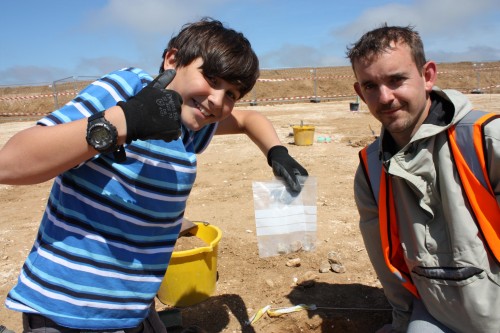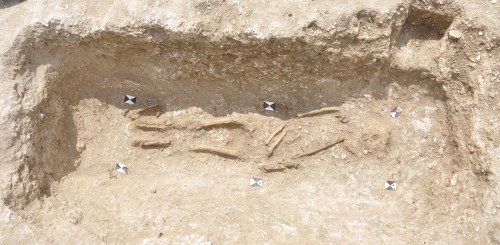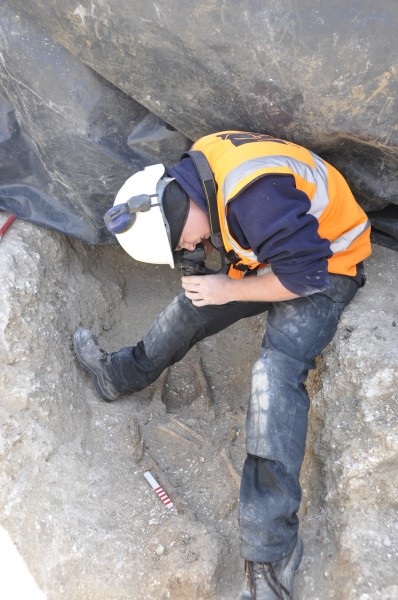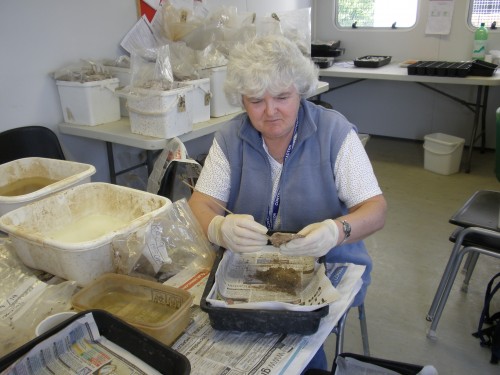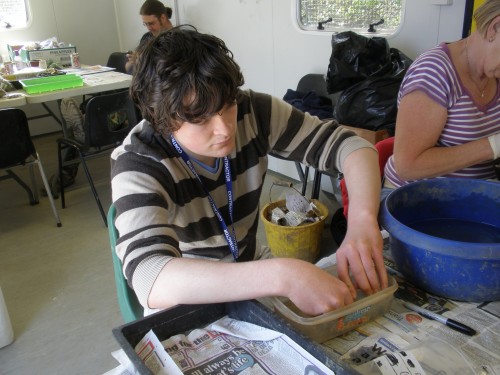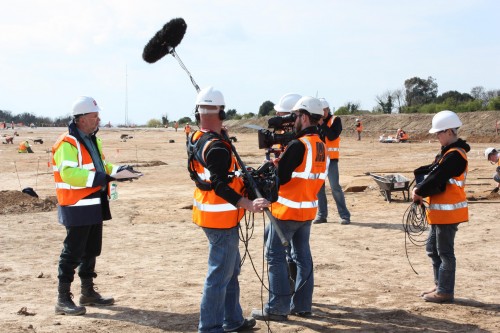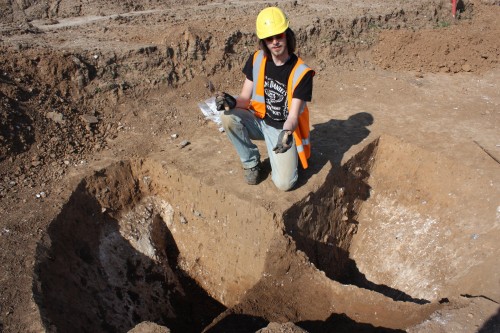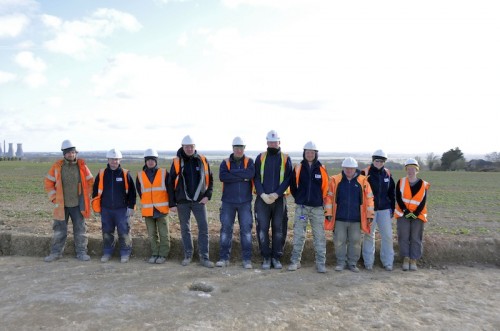Kent County Council say:
“Exciting archaeological discoveries are being made on Thanet this spring and local people are being asked to join the excavation and help.
Archaeologists are excavating and recording remains on the route of the East Kent Access Road on the Isle of Thanet in Kent. The excavation is the largest dig in the country in 2010: archaeologists will excavate an area over 6km in length before road works begin.
The new road is in an area particularly rich in archaeological remains from prehistoric, Roman and Saxon times. The road runs close to the mouth of the Wantsum Sea Channel, an important route that was a gateway for ancient peoples into Kent used by ships until medieval times. We think that a number of revolutionary events in British history took place in this area: the invading Roman Emperor Claudius landed at Richborough in AD43; the arrival of Saxons in the fifth century and later the landing of St Augustine with his mission to bring Christianity back to Britain in AD597.
Now the soil is removed important archaeological remains have been revealed all along the route. Among the important discoveries are: the remains of nine Bronze Age barrows (burial mounds) dating back over 3,500 years; numerous Iron Age enclosures and a village which lasted into Roman times at Ebbsfleet. There are also several areas of Roman settlement scattered across the landscape connected by tracks and roads, some of which are still in use today; Roman and Saxon cemeteries; Saxon buildings and a large Saxon enclosure with evidence of a huge shellfish feast. A medieval farmstead has been found close to Richborough Power Station.
The archaeological investigations are commissioned by Kent County Council through their road builders VolkerFitzpatrick Hochtief JV and are scheduled to continue into the summer.
A programme of talks and exhibitions will allow local people to see some of the archaeological remains as they are uncovered. Members of the public are encouraged to get involved by volunteering to help the archaeologists work on the artefacts and will have an opportunity to participate in a community excavation in one section of the route.
The East Kent Access Road will provide better road connections between the Isle of Thanet, the national motorway network, Kent International Airport, Canterbury and the European Gateways of Ramsgate, Dover and the Channel Tunnel with 8km of the A256 and A299 upgraded to dual carriageway.
The project is jointly funded by the Department of Transport (£81.25m) and Kent County Council (£5.75m) and should be complete in 2012.
The new road crosses one of the richest archaeological areas in Britain. Before the building starts, archaeologists will excavate along the whole length of the route. This will be the largest excavation in Britain in 2010, covering approximately 40 hectares.
Oxford Wessex Archaeology will carry out archaeological work on behalf of the company constructing the new road for Kent County Council, VolkerFitzpatrick Hochtief Joint Venture.
The archaeological work will be complete by mid-summer. Until then, there will be opportunities for the local community to visit the site and even help with the dig. For more information, please visit: https://eastkent.owarch.co.uk/
Exciting archaeological discoveries are being made on Thanet this spring and local people are being asked to join the excavation and help.
Archaeologists are excavating and recording remains on the route of the East Kent Access Road on the Isle of Thanet in Kent. The excavation is the largest dig in the country in 2010: archaeologists will excavate an area over 6km in length before road works begin.
The new road is in an area particularly rich in archaeological remains from prehistoric, Roman and Saxon times. The road runs close to the mouth of the Wantsum Sea Channel, an important route that was a gateway for ancient peoples into Kent used by ships until medieval times. We think that a number of revolutionary events in British history took place in this area: the invading Roman Emperor Claudius landed at Richborough in AD43; the arrival of Saxons in the fifth century and later the landing of St Augustine with his mission to bring Christianity back to Britain in AD597.
Now the soil is removed important archaeological remains have been revealed all along the route. Among the important discoveries are: the remains of nine Bronze Age barrows (burial mounds) dating back over 3,500 years; numerous Iron Age enclosures and a village which lasted into Roman times at Ebbsfleet. There are also several areas of Roman settlement scattered across the landscape connected by tracks and roads, some of which are still in use today; Roman and Saxon cemeteries; Saxon buildings and a large Saxon enclosure with evidence of a huge shellfish feast. A medieval farmstead has been found close to Richborough Power Station.
The archaeological investigations are commissioned by Kent County Council through their road builders VolkerFitzpatrick Hochtief JV and are scheduled to continue into the summer.
A programme of talks and exhibitions will allow local people to see some of the archaeological remains as they are uncovered. Members of the public are encouraged to get involved by volunteering to help the archaeologists work on the artefacts and will have an opportunity to participate in a community excavation in one section of the route. Further details are on www.eastkent.owarch.co.uk/.
——
The East Kent Access Road will provide better road connections between the Isle of Thanet, the national motorway network, Kent International Airport, Canterbury and the European Gateways of Ramsgate, Dover and the Channel Tunnel with 8km of the A256 and A299 upgraded to dual carriageway.
The project is jointly funded by the Department of Transport (£81.25m) and Kent County Council (£5.75m) and should be complete in 2012
The new road crosses one of the richest archaeological areas in Britain. Before the building starts, archaeologists will excavate along the whole length of the route. This will be the largest excavation in Britain in 2010, covering approximately 40 hectares.
Oxford Wessex Archaeology will carry out archaeological work on behalf of the company constructing the new road for Kent County Council, VolkerFitzpatrick Hochtief Joint Venture.
The archaeological work will be complete by mid-summer. Until then, there will be opportunities for the local community to visit the site and even help with the dig. For more information, please visit: https://eastkent.owarch.co.uk/”
